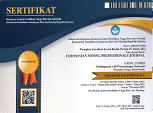Dynamic Analysis of Blasting Effect on Nanjung Tunnel Stability
Abstract
This study aims to dynamically analyze blasting conducted in the Nanjung tunnel. Nanjung Tunnel is a twin tunnel that has a horseshoe-shaped section with each tunnel having a dimension of 10.2 m x 9.2 m, and 230 meters in length. The layers rock of this tunnel include silty clay, sandstone and dacite. Blasting was carried out on one of the tunnels consisting of dacite rock, having a 75-90% RQD and UCS 49-61 MPa. During the blast, PPV measurements were taken at several points around the tunnel using a minimate.
Dynamic analysis is done by building a Nanjung Tunnel model on the RS2 software with the finite element method. Input data in this modeling is endeavored to approach actual conditions in the field, such as tunnel geometry, rock mass properties, and blasting plans carried out at STA 30-32 tunnels 2. This modeling is expected to produce PPV that is close to actual PPV and the results of this model will be continued to the stability analysis tunnel 1.
Modeling results indicate that the tunnel 1 condition is stable during blasting. The stability of tunnel 1 based on smallest strength factor on the roof is around 2.6. Stability also seen from the strain level in dacite and sandstone rocks which are 0.07% and 0.38%. These strain levels are still permissible according to the Sakurai strain level diagram, 1983.
Keywords
Full Text:
PDFReferences
Bieniawski, Z.T., (1989): Engineering Rock Mass Classification, A Complete Manual for Engineers and Geologist in Mining, Civil, and Petroleum Engineering. New York, Wiley-Interscience Publication.
Hoek, E., Brown, E.T., (1997): Practical Estimates of Rock Mass Strength, International Journal of Rock Mechanics and Mining Science, Elsevier.
Hoek, E., Brown, E.T., (1982): Underground Excavations in Rock, London, UK, E&FN Spon, an imprint of Chapman & Hall.
Hoien, E., Nilsen, B., Olsson, R., (2019): Main Aspect of Deformation and Rock Support in Norwegian Road Tunnels, Tunneling and Underground Space Technology, Elsevier.
Kementerian Pekerjaan Umum dan Perumahan Rakyat., (2018): Pengeboran Geoteknik Proyek Pembangunan Terowongan Nanjung, Laporan Akhir Subsurface Investigation Nanjung Tunnel Project, Suwanda Karya Mandiri.
Kwang Ahn, Jae., Park, Duhee., Kwon Yoo, Jin., (2015): Estimation of damping ratio of rock mass for numerical simulation of blas induced vibration propagation, Japanese Geotechnical Society Special Publication, Japan.
Nugroho, M. Fadli., (2014): Comparison of Predicted PPV Value By Using Empirical Equation and Its Artificial Neural Networks and Correlation With The Damage Resulted From Blasting Activities in Undercut DOZ Mine, Laporan Skripsi, Universitas Trisakti, Jakarta.
Oliveira, Moura., Vrancic, Damir., (2015): Underdamped Second-Order Systems Overshoot Control, International Journal of Control Automation and System, Sciencedirect.
Kementerian Pekerjaan Umum dan Perumahan Rakyat., (2018): Upper Citarum Basin Flood Management Sector Load Project, Detail Design Report For Nanjung Diversion Tunnel, Oriental Consultant Global Co.Ltd.
Rai, M.A., Kramadibrata S., Watimena, R.K., (2014): Mekanika Batuan, Institut Teknologi Bandung, Bandung.
Qingguo Liang., Jie Li., Dewu Li., Erfeng Ou. (2012): Effect of Blast-Induced Vibration from New Railway Tunnel on Existing Adjacent Railway Tunnel in Xinjiang, Journal of Rock Mechanics and Rock Engineering, DOI 10.1007/s00603-012-0259-5.
Qi Zhang., Xianbin Huang., Hehua Zhu., Jianchun Li. (2019): Quantitative Assessments of the Correlations between Rock Mass Rating (RMR) and Geological Strength Index (GSI), Journal of Tunneling and Underground Space Technology, Elsevier.
Suhendro, Bambang., Rifa’I, Ahmad., Aminullah, Ahmad., (2018): Analisis Stabilitas Konstruksi Terowongan Nanjung dengan Finite Element Method, Laporan Akhir Analisis Metode Elemen Hingga Proyek Terowongan Nanjung, Lembaga Kerjasama Fakultas Teknik UGM.
Ngo, T., Mendis, P., Gupta, A., Ramsay, J. (2007): Blast Loading and Blast Effect on Structures, International Journal of Loading on Structures , eJSE.
DOI: https://doi.org/10.36986/impj.v2i1.17
 views : 961
views : 961
Refbacks
- There are currently no refbacks.

This work is licensed under a Creative Commons Attribution-NonCommercial-ShareAlike 4.0 International License.


.png)


.png)









